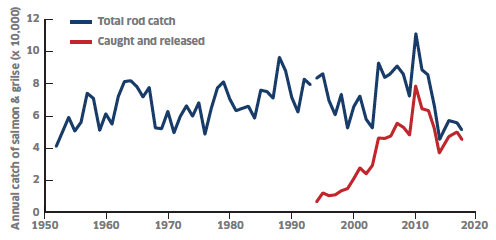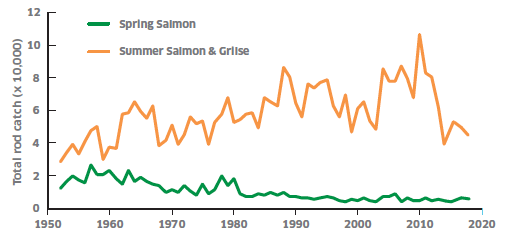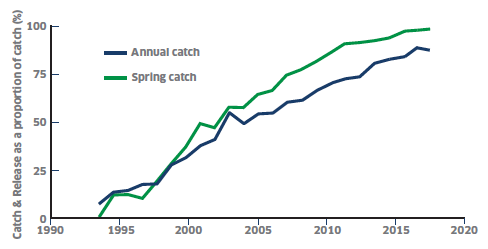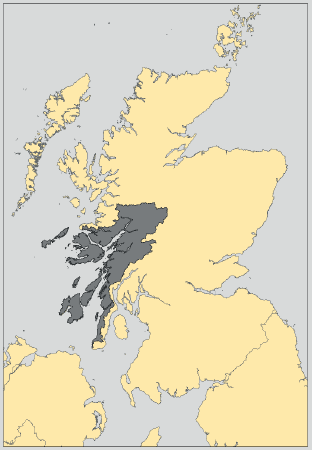Salmon fishery statistics: 2017 season
Salmon catch statistics for the 2017 season.
Salmon Fishery Statistics - 2017 Season
Summary
- The total reported rod catch (retained and released) of wild salmon and grilse for 2017 is 49,444. Total reported catch is 80% of the previous 5-year average and this is the fourth lowest on record.
- The proportion of the rod catch accounted for by catch and release is among the highest recorded. In 2017, 98% of rod caught spring salmon (multi sea-winter fish taken before 1 May) were released, as were 90% of the annual rod catch. A proportion of fish released from the rod fishery may be re-caught and hence inflate the catch statistics by appearing in the reported data more than once.
- Trends in rod catch varied among individual stock components. Reported catch of spring salmon has generally declined since records began and, although there is some indication that catch has stabilised in recent years, it remains at a historically low level. Overall catch of salmon and grilse in later months, on the other hand, generally increased up to 2010, after which it fell sharply over the next 4 years before recovering slightly in 2015 and 2016 only to fall again in 2017.
- Reported catch and effort for the fixed engine and net & coble fisheries were among the lowest recorded by either fishery since records began in 1952.
- Salmon and grilse reported as being of farmed origin represented 1% of the total Scottish catch in 2017. These catches are among the highest reported since records began in 1994. 96% of these catches were reported from the west coast region where they coincided with a reported escape of salmon from a farm in the area.
The Statistics
This publication summarises the salmon fishery statistics based on returns from proprietors, occupiers or agents of fisheries throughout Scotland for the 2017 fishing season. These data are derived from 1,963 forms returned from 2,116 forms issued (93% return rate). Final published statistics for the previous 10 years have been based on return rates of between 93% and 95%.
These statistics are part of a time series which began in 1952 and are collected and collated by Marine Scotland Science.
Salmon Fishery Regulations
Statutory conservation measures are in place to regulate both the killing of salmon in the early months of the fishing season ( http://www.gov.scot/Topics/marine/Salmon-Trout-Coarse/fishreform/licence/spring), in coastal waters and on stocks with poor conservation status ( http://www.gov.scot/Topics/marine/Salmon-Trout-Coarse/fishreform/licence/status).
These regulations will have an impact on the catch and effort data reported by Scottish salmon fisheries.
Catch And Effort Reported By Scottish Salmon Fisheries In 2017
The rod and line fishery
A total of 5,187 wild salmon and grilse was reported caught and retained in the rod and line fishery. A further 44,257 wild salmon and grilse were reported caught and released. The combined retained and released rod catch is 49,444, which is 80% of the previous 5-year average. We have no time series of fishing effort information associated with the rod and line fishery.
Annual rod catch generally increased over the period 1952 to 2010, declining in each subsequent year until 2014, the second lowest on record. Reported rod catch recovered slightly in 2015 and 2016 only to fall again in 2017 (Figure 1).
Figure 1: Rod And Line Fishery

Trends in total rod catch varied among individual stock components (Figure 2). Spring salmon catch (for the purposes of this report defined as multi sea-winter fish taken before 1 May) has generally declined since records began. Although stabilising in recent years, catches remain at a historically low level. Overall catch of salmon and grilse in later months generally increased up to 2010, after which it fell sharply only to recover slightly in 2015 and 2016 before falling 2017.
Figure 2: Trends In Stock Components, Rod And Line Fishery

Catch and release
The proportion of the rod catch accounted for by catch and release has generally increased since 1994, when such information was first recorded. In 2017, 90% of the annual rod catch was released compared to less than 8% in 1994. Similarly, less than 1% of rod caught spring salmon were released in 1994 while 98% were released in 2017 (Figure 3). A proportion of fish released from the rod fishery may be re-caught and hence inflate the catch statistics by appearing in the reported data more than once.
Figure 3: Catch And Release, Rod And Line Fishery

The net fisheries
Reported catch and effort for the fixed engine and net & coble fisheries in 2017 were among the lowest recorded by either fishery since records began in 1952. For net and coble fisheries, both catch and effort were the lowest in the time series while for fixed engines, effort was also the lowest since records began, while catch was the second lowest.
As a result of the Salmon Conservation Regulations, retention of salmon caught in coastal waters was prohibited.
On the Solway, a total of 35 wild salmon and grilse was reported caught and retained in a scientific haaf net fishery in the Annan district from a reported fishing effort of 135 net months. In the Nith district, a further 45 salmon and grilse were reported caught and retained in haaf fisheries from an effort of 109.5 net months.
Effort returns from Solway fisheries do not yield data that can be easily combined with returns from gear types in the rest of Scotland and data from this region are generally omitted when calculating a national index for fixed engine fishing effort. In 2017, fixed engine effort for Scotland excluding Solway was reported as 10 trap months with no salmon and grilse retained.
A total of 2,113 wild salmon and grilse was reported caught and retained in the net & coble fishery from a reported effort of 40 crew months.
The catch by fishing method
In 2017, approximately 96% of the total annual reported catch was accounted for by the rod fisheries. Net & coble fisheries comprised 4% with fixed engine fisheries accounting for around 0.1%. Restricting the analysis to the retained catch, the rods accounted for approximately 70% of the catch compared to 29% and 1% of the net & coble and fixed engine fisheries respectively.
In the spring, rod fisheries accounted for almost 100% of the total reported catch while net and coble catch comprised less than 0.1%. Of the retained catch, rod fisheries accounted for 99% while net and coble catches accounted for the remaining 1%.
Farmed salmon and grilse
A total of 605 fish of farmed origin was reported caught by all methods in 2017. Fish of farmed origin represented 1% of the total number of salmon and grilse caught in Scotland. These catches are among the highest reported since records began in 1994. 96% of these catches were reported from the west coast region (Figure 4) where they coincided with a reported escape of salmon from a farm in the area.
Figure 4: Map Showing West Coast Region (Grey)

Some Features Of The Map Are Based On Digital Spatial Data Licensed From Centre For Ecology And Hydrology © NERC. Coastline: OS Panorama 1:50,000, OS (100024655).
Downloads
Topic sheet no. 67 explains how we collect the catch statistics.
Topic sheet no. 69 summarises the sea trout fishery
statistics for the 2017 fishing season.
Both topic sheets are available for download at
http://www.gov.scot/Topics/marine/Publications/TopicSheets/tslist
Summary data for fishing seasons 1952 to 2017 are available for
download at
http://www.gov.scot/Topics/marine/science/Publications/stats/SalmonSeaTroutCatches
These data are provided as the most complete at the time of publication. Our records are amended when further information becomes available and updated annually in April when the statistics for the most recent fishing season are published.
Contact
If you have a specific request for Scottish salmon and sea trout fishery information, not available at the links on this page, please contact us directly at ms.catchform@gov.scot
Contact
There is a problem
Thanks for your feedback